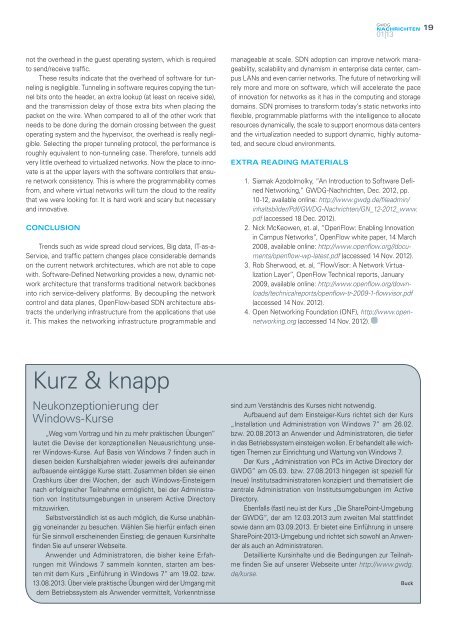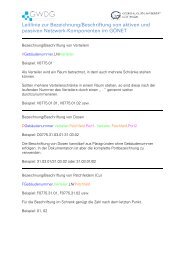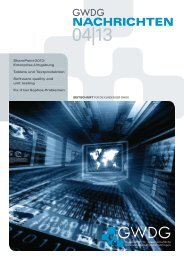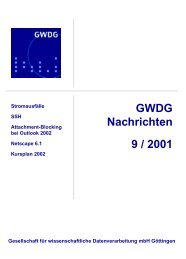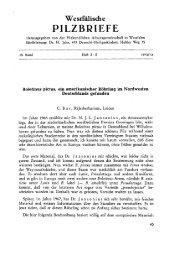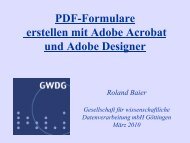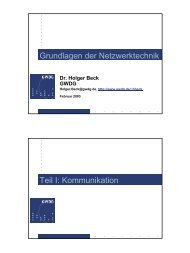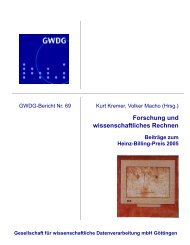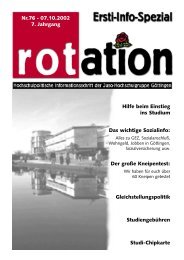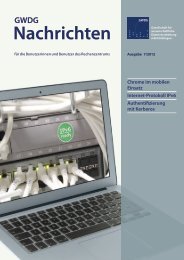GWDG-Nachrichten 1/2013
GWDG-Nachrichten 1/2013
GWDG-Nachrichten 1/2013
Erfolgreiche ePaper selbst erstellen
Machen Sie aus Ihren PDF Publikationen ein blätterbares Flipbook mit unserer einzigartigen Google optimierten e-Paper Software.
not the overhead in the guest operating system, which is required<br />
to send/receive traffic.<br />
These results indicate that the overhead of software for tunneling<br />
is negligible. Tunneling in software requires copying the tunnel<br />
bits onto the header, an extra lookup (at least on receive side),<br />
and the transmission delay of those extra bits when placing the<br />
packet on the wire. When compared to all of the other work that<br />
needs to be done during the domain crossing between the guest<br />
operating system and the hypervisor, the overhead is really negligible.<br />
Selecting the proper tunneling protocol, the performance is<br />
roughly equivalent to non-tunneling case. Therefore, tunnels add<br />
very little overhead to virtualized networks. Now the place to innovate<br />
is at the upper layers with the software controllers that ensure<br />
network consistency. This is where the programmability comes<br />
from, and where virtual networks will turn the cloud to the reality<br />
that we were looking for. It is hard work and scary but necessary<br />
and innovative.<br />
CoNCluSioN<br />
Trends such as wide spread cloud services, Big data, IT-as-a-<br />
Service, and traffic pattern changes place considerable demands<br />
on the current network architectures, which are not able to cope<br />
with. Software-Defined Networking provides a new, dynamic network<br />
architecture that transforms traditional network backbones<br />
into rich service-delivery platforms. By decoupling the network<br />
control and data planes, OpenFlow-based SDN architecture abstracts<br />
the underlying infrastructure from the applications that use<br />
it. This makes the networking infrastructure programmable and<br />
Kurz & knapp<br />
Neukonzeptionierung der<br />
Windows-Kurse<br />
„Weg vom Vortrag und hin zu mehr praktischen Übungen“<br />
lautet die Devise der konzeptionellen Neuausrichtung unserer<br />
Windows-Kurse. Auf Basis von Windows 7 finden auch in<br />
diesen beiden Kurshalbjahren wieder jeweils drei aufeinander<br />
aufbauende eintägige Kurse statt. Zusammen bilden sie einen<br />
Crashkurs über drei Wochen, der auch Windows-Einsteigern<br />
nach erfolgreicher Teilnahme ermöglicht, bei der Administration<br />
von Institutsumgebungen in unserem Active Directory<br />
mitzuwirken.<br />
Selbstverständlich ist es auch möglich, die Kurse unabhängig<br />
voneinander zu besuchen. Wählen Sie hierfür einfach einen<br />
für Sie sinnvoll erscheinenden Einstieg; die genauen Kursinhalte<br />
finden Sie auf unserer Webseite.<br />
Anwender und Administratoren, die bisher keine Erfahrungen<br />
mit Windows 7 sammeln konnten, starten am besten<br />
mit dem Kurs „Einführung in Windows 7“ am 19.02. bzw.<br />
13.08.<strong>2013</strong>. Über viele praktische Übungen wird der Umgang mit<br />
dem Betriebssystem als Anwender vermittelt, Vorkenntnisse<br />
manageable at scale. SDN adoption can improve network manageability,<br />
scalability and dynamism in enterprise data center, campus<br />
LANs and even carrier networks. The future of networking will<br />
rely more and more on software, which will accelerate the pace<br />
of innovation for networks as it has in the computing and storage<br />
domains. SDN promises to transform today’s static networks into<br />
flexible, programmable platforms with the intelligence to allocate<br />
resources dynamically, the scale to support enormous data centers<br />
and the virtualization needed to support dynamic, highly automated,<br />
and secure cloud environments.<br />
extra reaDiNG materialS<br />
01|13<br />
1. Siamak Azodolmolky, “An Introduction to Software Defined<br />
Networking,” <strong>GWDG</strong>-<strong>Nachrichten</strong>, Dec. 2012, pp.<br />
10-12, available online: http://www.gwdg.de/fileadmin/<br />
inhaltsbilder/Pdf/<strong>GWDG</strong>-<strong>Nachrichten</strong>/GN_12-2012_www.<br />
pdf (accessed 18 Dec. 2012).<br />
2. Nick McKeowen, et. al, “OpenFlow: Enabling Innovation<br />
in Campus Networks”, OpenFlow white paper, 14 March<br />
2008, available online: http://www.openflow.org//documents/openflow-wp-latest.pdf<br />
(accessed 14 Nov. 2012).<br />
3. Rob Sherwood, et. al, “FlowVisor: A Network Virtualization<br />
Layer”, OpenFlow Technical reports, January<br />
2009, available online: http://www.openflow.org/downloads/technicalreports/openflow-tr-2009-1-flowvisor.pdf<br />
(accessed 14 Nov. 2012).<br />
4. Open Networking Foundation (ONF), http://www.opennetworking.org<br />
(accessed 14 Nov. 2012).<br />
sind zum Verständnis des Kurses nicht notwendig.<br />
Aufbauend auf dem Einsteiger-Kurs richtet sich der Kurs<br />
„Installation und Administration von Windows 7“ am 26.02.<br />
bzw. 20.08.<strong>2013</strong> an Anwender und Administratoren, die tiefer<br />
in das Betriebssystem einsteigen wollen. Er behandelt alle wichtigen<br />
Themen zur Einrichtung und Wartung von Windows 7.<br />
Der Kurs „Administration von PCs im Active Directory der<br />
<strong>GWDG</strong>“ am 05.03. bzw. 27.08.<strong>2013</strong> hingegen ist speziell für<br />
(neue) Institutsadministratoren konzipiert und thematisiert die<br />
zentrale Administration von Institutsumgebungen im Active<br />
Directory.<br />
Ebenfalls (fast) neu ist der Kurs „Die SharePoint-Umgebung<br />
der <strong>GWDG</strong>“, der am 12.03.<strong>2013</strong> zum zweiten Mal stattfindet<br />
sowie dann am 03.09.<strong>2013</strong>. Er bietet eine Einführung in unsere<br />
SharePoint-<strong>2013</strong>-Umgebung und richtet sich sowohl an Anwender<br />
als auch an Administratoren.<br />
Detaillierte Kursinhalte und die Bedingungen zur Teilnahme<br />
finden Sie auf unserer Webseite unter http://www.gwdg.<br />
de/kurse.<br />
Buck<br />
19


